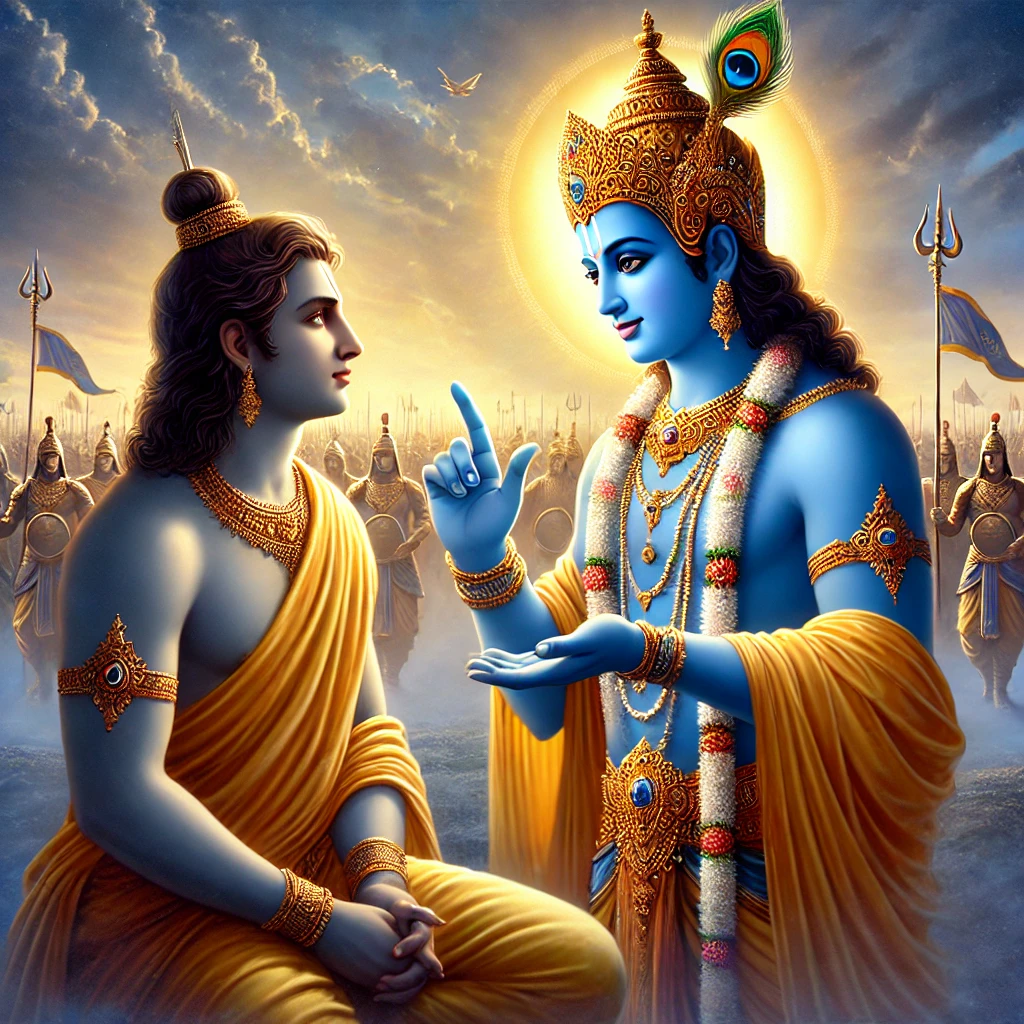The third chapter of the Bhagavad Gita, known as Karma Yoga, is a profound discourse on the importance of selfless action. In this chapter, Lord Krishna explains to Arjuna why action is necessary and how one can attain spiritual liberation through duty performed without selfish motives.
1. Why Action is Necessary?
At the beginning of this chapter, Arjuna is confused. In the second chapter, Krishna spoke about the wisdom of renunciation (Jnana Yoga) and the importance of detachment. Arjuna wonders: if knowledge is superior, why should he fight? Wouldn’t renouncing action be better?
Krishna clears this doubt by explaining that action is inevitable—no one can remain inactive. Even for a moment, we are constantly engaged in some form of activity, whether consciously or unconsciously. Thus, it is better to engage in righteous action rather than escape from it.
2. The Philosophy of Karma Yoga
Krishna introduces the concept of Nishkama Karma—selfless action without attachment to the fruits of labor. He says:
“Your right is to perform your duty only, but never to its fruits. Do not be motivated by the results of actions, nor be attached to inaction.” (Gita 3.47)
This means that one should focus on performing their duties sincerely and ethically without worrying about personal gains or losses.
Example:
A teacher should teach with full dedication, not just for salary or recognition. A soldier should fight for justice, not for personal rewards. A doctor should treat patients with care, not just for monetary benefit.
When actions are performed selflessly, they purify the mind, destroy ego and desires, and ultimately lead to spiritual growth.
3. The Role of Duty (Dharma)
Krishna emphasizes that every individual has a Swadharma (personal duty) based on their skills and responsibilities. Performing one’s duty with sincerity upholds the cosmic order (Dharma).
“It is better to do one’s own duty imperfectly than to do another’s duty perfectly.” (Gita 3.35)
This means that we should focus on fulfilling our own responsibilities rather than trying to imitate others.
Example:
A warrior’s duty is to protect. If Arjuna, as a warrior, refuses to fight a righteous war, he would fail in his duty and create disorder.
4. The Role of Leadership
Krishna also explains that leaders and role models have a great responsibility in society. Whatever they do, common people follow.
“Whatever a great person does, others follow. Whatever standards they set, others will imitate.” (Gita 3.21)
This means that leaders should set a good example by performing their duties with sincerity, discipline, and selflessness.
Example:
- A teacher who is honest and hardworking inspires students to be the same.
- A leader who serves people selflessly encourages citizens to contribute to society.
5. The Three Gunas and Influence on Action
Krishna explains that all actions are influenced by the three Gunas (qualities of nature):
- Sattva (Purity, Knowledge) – Leads to wisdom and righteousness.
- Rajas (Passion, Activity) – Leads to ambition and desires.
- Tamas (Ignorance, Laziness) – Leads to negligence and chaos.
A person should strive to rise above these influences by performing selfless actions with awareness and devotion.
6. How to Overcome Desire and Ego?
Krishna warns that desire (Kama) and anger (Krodha) are enemies of spiritual growth. They arise from Rajas Guna and lead to attachment and suffering.
“Desire and anger are born of passion. They are insatiable and extremely sinful. Know them as the enemies of the soul.” (Gita 3.37)
The way to overcome desires is through:
- Self-discipline (controlling the mind and senses).
- Devotion (offering all actions to God).
- Wisdom (understanding the temporary nature of worldly pleasures).
7. Conclusion – The Path to Liberation
Krishna concludes by saying that performing actions with devotion and without selfishness leads to liberation (Moksha). The key is to dedicate every action to God, seeing oneself as an instrument of the divine will.
By following Karma Yoga, one attains:
- Inner peace and detachment.
- Fulfillment of duty without stress.
- Spiritual progress towards liberation.
Thus, instead of escaping from responsibilities, one should transform everyday actions into a path of self-realization through selfless service.
Final Thought
The third chapter of the Gita teaches us how to live a balanced life—fulfilling our duties without attachment while cultivating inner peace and wisdom. It is a guide for everyone, whether a leader, student, parent, or professional. By practicing Karma Yoga, we can live a life of meaning, purpose, and harmony.
Which lesson from Karma Yoga resonates most with you? Let me know in the comments!

Leave a Reply